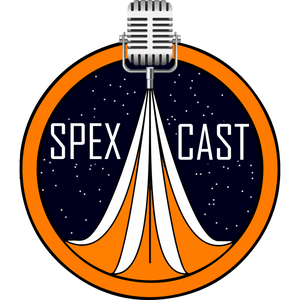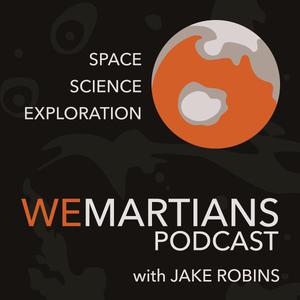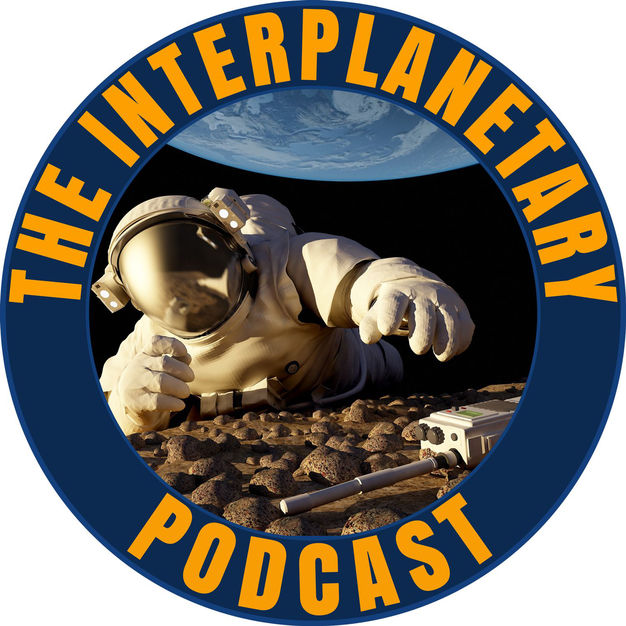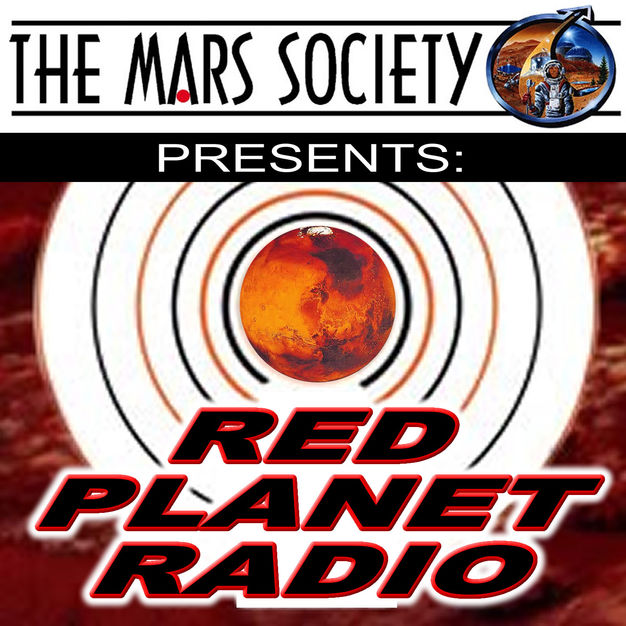
Talking Space
Gene Mikulka, Mark Ratterman & Sawyer Rosenstein
A Free and Open Exchange of Ideas and Opinions on All Things Space. Be sure to follow us on Twitter: @talkingspace!
- 37 minutes 9 secondsEpisode 1614: Talking Space Retrospective, Part 2
It was September 9, 2009; aka 09/09/09.
That was the easy-to-remember air date of the first episode of Talking Space. The Space Shuttle era was ending. As far as most of the public was concerned, that represented the death knell for the U.S. Space Program. But Gene, Mark and Sawyer knew better, and they were trying to figure out how to best spread the word that all was not lost.
Thus, Talking Space was born. And what a ride it’s been.
In Part 2 of this retrospective (Part 1 can be found here), the team reveals:
- The role of audience feedback – pros and cons, and the methods by which we receive it (and don’t, despite our best efforts);
- Our social media follies;
- The behind-the-scenes scrambles to cover launch anomalies;
- The proven importance of dissimilar redundancy, as well as interoperability;
- How we’ve dealt with the occasional bouts of podcast burnout over the last 15 years, because sometimes we just get tired, you know? And sometimes, Life just gets in the way. Those are the times we’re glad we’re not doing this podcasting stuff alone.
And we also talk about how much we value feedback from you, our listeners – even when you let us know you do not particularly agree with us.
Be sure to let us know your thoughts on the topics we discuss. You can always reach us at [email protected] .
Show recorded 09-19-2023.
Host: Larry Herrin
Panelist(s): Gene Mikulka, Mark Ratterman, Sawyer Rosenstein and Dr. Kat Robison
Podcast Editor: Larry Herrin
9 November 2024, 6:45 pm - 1 hour 12 minutesEpisode 1613: Talking Space Retrospective, Part 1
It was September 9, 2009; aka 09/09/09.
That was the easy-to-remember air date of the first episode of Talking Space. The Space Shuttle era was ending. For most casual observers, that represented the death knell for the U.S. Space Program. But Gene, Mark and Sawyer knew better, and they were trying to figure out how to best spread the word that all was not lost.
Back then, there were basically only three places to publish a podcast: iTunes, Yahoo and your own website (probably made with Wordpress). Apple didn’t launch its first standalone Apple Podcasts mobile app until 2012. The app was later pre-installed with iOS beginning October 2014.
Now, you can listen to Talking Space on any of what seems like dozens of available podcast aggregation apps.
So, as our gift to you, you get to hear us talk about ourselves for a change – like it or not. Yay!
This time around, our entire on-air team (as it existed when this episode was recorded on September 19, 2023) lets their collective hair down to celebrate and reminisce about how Talking Space got started back in those Wild West days of podcasting. We also discuss how each of us came to find a way to be a part of it. We’ll reveal the "challenging" episodes, the ones that caused us joy, the occasionally stressful times, and the often very rewarding times.
Listen in as we share behind-the-scenes stories of covering historic events, interviewing legendary astronauts, and navigating the ever-evolving world of space exploration.
Discover how Talking Space has grown and adapted over the years, embracing new formats and audiences while staying true to its mission of delivering in-depth analysis and commentary. Whether you're a long-time listener or new to the podcast, this episode offers a unique glimpse into the passion and dedication that drives the Talking Space team.
Don't miss Part 1 of this engaging and nostalgic look back at the past 14 years of Talking Space.
And then, stay tuned for Part 2, coming soon, where the conversation continues!
Be sure to let us know your thoughts on the topics we discuss. You can always reach us at [email protected] .
Show recorded 09-19-2023.
Host: Larry Herrin
Panelist(s): Gene Mikulka, Mark Ratterman, Sawyer Rosenstein and Dr. Kat Robison
Podcast Editor: Larry Herrin
13 October 2024, 8:18 pm - 1 hour 50 minutesEpisode 1612: EPA, TCEQ Cite SpaceX for Starbase Clean Water Act Violations
Environmental regulators are beginning to clamp down on Starbase. The big question is: Do these enforcement actions have enough significance to force the FAA to delay launch activities at Boca Chica?
Some troubling headlines appeared on CNBC.com on Monday, August 12, 2024 concerning SpaceX’s alleged issues regarding compliance with environmental regulations that govern their activities at the Starbase facility in Boca Chica, Texas.
The story by Lora Kolodny alleges that “Elon Musk’s SpaceX violated environmental regulations by repeatedly releasing pollutants into or near bodies of water in Texas, a state agency said in a notice of violation focused on the company’s water deluge system at its Starbase launch facility.
“The notice from the Texas Commission on Environmental Quality (TCEQ) last week came five months after the Environmental Protection Agency Region 6 office, which covers Texas and surrounding states, had also informed SpaceX that it violated the Clean Water Act with the same type of activity.”
SpaceX finally submitted an application for an Industrial Wastewater Individual Permit on July 1, 2024. It was later revised, and the revised application was submitted August 14, 2024.
Beginning at 45:20 of this episode we discuss the following: SpaceX posted a response on X in the afternoon of August 12. It dubbed the CNBC story “factually inaccurate,” and revealed additional interesting information that was previously unknown to us.
So Many Questions…We’re devoting this looonng episode (sorry!) to an analysis of these developments, and Eric Roesch is back with us to help give it all the once-over. And you know that wherever Eric is, a controversial, SpaceX-related environmental issue can’t be far behind. Among the topics we’ll discuss:
- What exactly happened here?
- The classic question: What did SpaceX know, and when did they know it?
- Do these enforcement actions have enough significance to force the FAA to delay launch activities at Boca Chica?
- How much worse can SpaceX make it by continuing to use the water deluge system before a permit is issued?
- What are the potential consequences for these violations? Could anyone actually go to jail?
- In SpaceX’s response post on X, why don’t some of SpaceX’s assertions make sense?
- Why did the FAA on Monday (the same day the CNBC story broke) cancel previously scheduled public hearings on the new draft Environmental Assessment for Boca Chica which requests a higher launch cadence and use of a bigger, more powerful and louder version of Starship than is currently in use?
Please be sure to let us know your thoughts on the topics we discuss. You can always reach us at [email protected]. You now have a way to easily send us a voice recording that we may use on the show: just click on the blue microphone icon at the bottom right of any page at TalkingSpaceOnline.com.
Show recorded 08-13-2024.
Host: Larry Herrin
Panelist(s): Heather Smith and Eric Roesch (Gene Mikulka, Mark Ratterman, Dr. Kat Robison and Sawyer Rosenstein will return)
Podcast Editor: Larry Herrin
TalkingSpaceOnline.com episode page photo credits:
Boca Chica OLM water deluge system test on July 27, 2023: SpaceX/X
18 August 2024, 10:41 pm - 1 hour 36 minutesEpisode 1611: Dissimilar Redundancy
NASA has tried to get Extra Vehicular Activity Number Ninety underway since June 13th. The first attempt was thwarted by a space suit comfort issue, the second by a water leak that created a blizzard of ice inside the Quest airlock. Are the Shuttle-Era Extra Vehicular Mobility Units (EMU) or space suits finally showing their age? Also, what about Collins Aerospace and their recent withdrawal from their NASA contract to build the next generation of space suits for the ISS and the Artemis Lunar Program when they indicated back in February that all was going well? We discuss.
On June 17th, the FAA held a virtual public hearing to receive comments concerning SpaceX’s plans to use Launch Complex 39-A and NASA’s Kennedy Space Center to support Starship Super Heavy Launches. We discuss what occurred during the session and the fallout from statements put into the record by both Blue Origin and United Launch Alliance.
Talking Space continues our Boeing Space CST-100 Starliner Crewed Flight Test coverage. The team continues to examine the “Starliner is Stuck at the ISS” misconceptions and asks what NASA & Boeing Space could have done to alleviate such headlines. We also look at a detailed explanation posted on Twitter from Jim May, a Boeing Engineer who was part of the NASA-TV coverage, of why “Calypso” remains on the ISS. The basis of his discussion comes from the actual NASA flight certification plan. Heather Smith mentions the observations of a NASA flight director and his assessment of how Starliner performed during its first actual safe-haven exercise.
All this and more in this edition of Talking Space!
(Recorded July 5th, 2024)
Host: Larry Herrin
Panel Members: Gene Mikulka, Mark Ratterman, Heather Smith
12 July 2024, 11:42 pm - 1 hour 14 minutesEpisode 1610: How GOES-U?
The Geosynchronous Operational Environmental Satellite, GOES-U, launched at 5:26 PM EDT on 25 June 2024 from Launch Complex 39 A at NASA’s Kennedy Space Center in Cape Canaveral, Florida.
A SpaceX Falcon Heavy took the 6000-pound satellite to its geostationary orbit in the Western Hemisphere. After a commissioning process, GOES –U will be renamed GOES 19 and take over the GOES EAST duties, standing sentinel, watching for severe storms, hurricanes, and wildfires. A unique option on this spacecraft: it can keep an eye on Coronal Mass Ejections or CMEs from the Sun.
This episode is an all-you-can-eat GOES fest, complete with GOES-U Falcon Heavy launch audio at the beginning and a related special audio treat at the end of the episode.
Mark Ratterman was at the Kennedy Space Center press site representing Talking Space during launch activities and was able to talk to several key players of the GOES-U team. In this episode you'll hear from:
John Gagosian - Director, NASA Joint Agency Satellite Division
Krizia Negron - Language Program Lead, National Weather Service Office of Science and Technology Integration, NOAA
Chris Reith - Program Manager, Advanced Baseline Imager, L3-Harris Technologies Mr. Reith is also working on NOAA's follow-up to the GOES series: The GeoXO program
Ken Graham – Director, National Weather Service
If you wish to take a look at what the GOES satellites have seen and how their images have evolved over the years, NOAA has on their website a "Cool Image Retrospective" page, have a look here.
Please be sure to let us know your thoughts on the topics we discuss. You can always reach us at [email protected]. You now also have a way to easily send us a voice recording that we may use on the show: just click on the blue microphone icon at the bottom right of any of our web pages at TalkingSpaceOnline.com.
Show recorded 07-03-2024.
Host: Larry Herrin
Segment Producer: Mark Ratterman
Panelists: Gene Mikulka, Heather D. Smith
Podcast Editor: Gene Mikulka
GOES-U Falcon Heavy – website photo credit: NASA
8 July 2024, 5:35 pm - 50 minutes 45 secondsSpecial Episode 1609A: Boeing's Starliner is NOT in Peril.
“Starliner Stuck In Space!!!”, “Starliner Stranded at the ISS!!”, “Space-X To Rescue Starliner Crew!!!” These were the various outrageous headlines being thrown around by various space media outlets this week, concerning the Boeing Starliner Mission and its progress. None of these sensational headlines are true, the ship and crew are in good condition but the media claims that the Starliner mission is in a grave situation, remain.
In this special edition of Talking Space, Gene Mikulka and Heather Smith take the time to sort through the chaff that is out there about the mission and offer insight into what is going on. We explore why it is not just the usual social media suspects perpetuating the myth about a broken spacecraft and a “crew in peril” but mainstream media has been jumping on the same bandwagon.
There have been some exceptions to the rule the social media rule: the YouTube channel Overlook Horizon released a fairly good video explaining some of the mission details that we also touch on, in this installment. The video does speculate what a Dragon rescue might look like, however, our show does not examine that possibility. Given the information that NASA and Boeing have presented in thier joint press conferences, such speculation on our part was not needed or required.
As of this writing, Starliner remains docked to the ISS, in a good, healthy state, ready to support crew return. Butch Wilmore and Suni Williams continue to support the balance of the Expedition 71 crew in their ISS science and maintenance duties.
Our usual format picks up next time with an upcoming deep dive into the GOES-U launch and more!
Host
Gene Mikulka
Panel Member: Heather Smith
28 June 2024, 8:27 pm - 1 hour 20 minutesEpisode 1609: Double Stars Rising
After years of development, testing, disappointment, and perseverance, NASA astronauts Butch Wilmore and Suni Willams took Boeing's CST 100 Starliner to the International Space Station for its first flight with a human crew. The team discusses all facets of the launch, rendezvous, docking (not without its moments of drama), and public reaction to the mission thus far.
Also this week, the fourth test flight of the SpaceX Starship Super-Heavy booster and a re-entry test of the Starship vehicle itself. The super-heavy vehicle is critical for NASA's Artemis lunar landing program, and a derivative of Starship was selected by NASA to be the human lunar lander used on Artemis III. The team puts the fourth Starship test into perspective.
Starship development was also critical for the SpaceX/ Yusaku Maezawa dearMoon program, which was to take Maezawa and eight invitees into orbit around the Moon. However, Maezawa announced that since a 2023 launch had become "unfeasible" and lacked a "clear schedule," he was canceling the program. The announcement drew some ire in the space community, and we examine the fallout.
One of The Hubble Space Telescope's three gyroscopes used to point the telescope to distant objects has failed. We look at a Media Telecon where NASA's astrophysics leader, Dr. Mark Clampen, indicated the agency will continue to utilize Hubble in a "one gyro mode" so the iconic telescope can still deliver good science with only a 20% loss of capability. The orbiting telescope is in overall good health and should continue to operate until 2035. At the same teleconference, Dr. Clampen announced that NASA has no intention of launching a Hubble servicing or re-boost mission in the foreseeable future. This news ends the SpaceX/Polaris plan to launch a possible servicing mission to the telescope. A May 2024 NPR article by Nell GreenfeldBoyce also reported NASA's concerns about the unsolicited proposal.
Sadly, the past few episodes have ended in obituaries, and that trend continues. The team takes a few moments to remember NASA Apollo 8 Astronaut William Anders, who died in a plane crash this past weekend.
All this and more in this edition of Talking Space!
UPDATE ONE: During the show, we reported that the new undock date for Starliner was on 22 June. After we published, NASA and Boeing decided to do some more analysis on the thruster issues experienced during last week's docking to the ISS. To understand the Starliner Service Module more, ( the service module does not return ) NASA and Boeing have now indicated that Starliner will undock from the ISS at 10:10 PM EDT on Tuesday, June 25th with a landing planned at the White Sands Space Harbor in New Mexico at 4:51 AM EDT on June 26th.
UPDATE TWO: In A Blog Post Today (21 June 2024) NASA and Boeing Space announced that they are waiving the return date of 26 June for Starliner, with a new date to be announced at a later time. To quote the NASA blog post: " The move off Wednesday, June 26, deconflicts Starliner’s undocking and landing from a series of planned International Space Station spacewalks while allowing mission teams time to review propulsion system data."
Steve Stitich, NASA's Commercial Crew Program manager said “We are strategically using the extra time to clear a path for some critical station activities while completing readiness for Butch and Suni’s return on Starliner and gaining valuable insight into the system upgrades we will want to make for post-certification missions.”
NASA Reports that Starliner remains healthy and that CFT Crew Members Butch Wilmore and Suni Williams continue to support the Expedition 71 Crew with their activities on the International Space Station.
Talking Space will continue to follow the story as it develops.
Host: Gene Mikulka
Panel Members: Mark Ratterman, Heather Smith
18 June 2024, 1:44 am - 1 hour 37 minutesEpisode 1608: Good Things Come To Those Who Wait
May 6th was going to be the date that Astronauts Butch Wilmore and Sunni Williams were going to take the Boeing CST 100 Starliner spacecraft to the International Space Station for the first time with astronauts on board. Starliner has undergone a rather stormy development period and is several years behind schedule as a result but NASA, Boeing, and United Launch Alliance (ULA) teams after the earlier flight readiness review were confident that the spacecraft was ready for crewed flight. The mission also marked the first time since Leroy Gordon Cooper’s Mercury-Atlas 9 on May 15th, 1963, that a human was going to ride to orbit on the “shoulders” of an Atlas launch vehicle. Even the weather for the attempt on May 6th was 95 percent “go.”
Unfortunately, the May 6th date was not to be. A cranky valve on board the Second Stage (Centaur Stage) of the ULA Atlas V kept Starliner on the ground. We explore what exactly happened, put the event in context, and gauge public reaction on various social media outlets. We also take a look at a rather explosive claim from a New York-based NASA contractor, ValveTech, about the component in question and debunk the Company’s claims.
If you live in North America, did you catch the aurora this past weekend? A Class 4 Geomagnetic storm was the cause, the first Class 4 solar storm warning issued by NOAA since 2005. NOAA called a press conference about potential impacts on Friday, May 10th, calling the event “potentially historic.” What were the impacts here on Earth or did it pose issues for the International Space Station? We discuss.
The US Senate Commerce, Science and Transportation Committee approved the FAA Reauthorization Act which extends the period where the FAA's Office of Commercial Space Transportation (AST) would be limited from regulating the safety of commercial human spaceflight, more commonly known as the “learning period.” Also, the FAA announced public meetings to occur next month to get public comments on an Environmental Impact Study on allowing Starship Super Heavy launches from NASA's Launch Complex 39A. All comments should be submitted by one of the methods listed under "ADDRESSES" in the linked document no later than June 24, 2024. We examine both stories.
Tokyo’s Astroscale announced that it had conducted the first rendezvous with a spent rocket upper stage in Earth Orbit. The idea is to understand how such an object behaves as a prelude to determining how to dispose of such an object properly. We take a brief look at their plans.
All this and more in this edition of Talking Space!
Please be sure to let us know your thoughts on the topics we discuss. You can always reach us at [email protected]. You now also have a way to easily send us a voice recording that we may use on the show: just click on the blue microphone icon at the bottom right of any page at TalkingSpaceOnline.com.
Show recorded 05-12-2024.
Host: Larry Herrin
Panelist(s): Gene Mikulka, Heather Smith (Mark
Ratterman, Dr. Kat Robison and Sawyer Rosenstein will return)
Podcast Editor: Larry Herrin
Space Debris – website photo credit: Astroscale
Aurora Borealis -- website photo credit: Dr. Kat Robison
NOTE: As of the recording date of the episode, the next launch attempt for Starliner was May 17th. That has since been changed. Due to a stubborn helium tank system leak, the latest date: NET May 25th at 3:09 PM EDT (1909 UTC). This new date is tentative as of this writing, and is subject to change.
17 May 2024, 7:45 pm - 44 minutes 19 secondsEpisode 1607: Staying Healthy in Space: Unpacking the GEARS Experiment
In this special episode of Talking Space, we delve into a rarely discussed, but crucial aspect of living in space: health and sickness. We're putting the spotlight on the unique challenges posed by bacterial and viral infections aboard the International Space Station (ISS) and future long-duration missions.
We're bringing you a deep dive into a groundbreaking experiment, GEARS (Genomic Enumeration of Antibiotic Resistance in Space), recently transported to the ISS. What is the aim of this experiment? How can analyzing the genetic makeup of antibiotic-resistant microbes in space help us on Earth?
Joining us for this insightful conversation are Dr. Sarah Wallace, a NASA microbiologist at the Johnson Space Center’s Biomedical research and Environmental Sciences Division Microbiology Laboratory, and Dr. Christopher Carr, co-director of the Georgia Tech Astrobiology Program. They'll shed light on the history of sickness on the ISS, the precautions in place, and the worst-case scenarios of illness or injury that have occurred.
How do astronauts maintain personal hygiene in space? What kind of medical supplies are available aboard the ISS? Tune in to find out.
We're also discussing the specifics of the GEARS experiment. What unique insights can we glean from the genetic makeup of bacteria in space? How will this knowledge shape the future of long-duration space missions?
With the advent of commercial LEO destinations, how is the space industry preparing for microbial challenges? What discussions are under way to make new stations more resistant to accumulating microbes?
Lastly, we tackle the ultimate Doomsday medical scenario: What would happen in case of a serious illness outbreak on the ISS or during a long-term flight to Mars? We'll discuss how scientists are trying to mitigate the potential dangers of bringing Earth germs to another planet and the risks of bringing something dangerous back to Earth.
Don't miss this episode of Talking Space as we navigate the intriguing world of health and sickness in space.
Please be sure to let us know your thoughts on the topics we discuss. You can always reach us at [email protected]. You now also have a way to easily send us a voice recording that we may use on the show: just click on the blue microphone icon at the bottom right of any page at TalkingSpaceOnline.com.
Show recorded 04-18-2024.
Host: Larry Herrin
Panelist(s): Mark Ratterman (Gene Mikulka, Dr. Kat Robison and Sawyer Rosenstein will return)
Podcast Editor: Larry Herrin
GEARS experiment – website photo credit: Planetary eXploration Lab (PXL)
Sarah Wallace - website photo credit: NASA
Christopher Carr - website photo credit: Planetary eXploration Lab (PXL)
6 May 2024, 8:55 pm - 34 minutes 37 secondsEpisode 1606: Delta 4 Heavy Recap; Coping with Mars Sample Return Budget
Welcome to another episode of Talking Space, where we bring you the latest updates on space exploration and technology. In this episode, we're excited to introduce our new team member, Heather Smith, who brings her passion for space to our discussions. Welcome, Heather!
- The episode kicks off with news about Slovenia signing the Artemis Accords. These accords outline best practices for sustainable space exploration and Slovenia is the third European country to sign them in less than a week, closely following Switzerland and Sweden.
- Next, we delve into the Mars Sample Return Mission. This ambitious mission aims to bring back samples from Mars to Earth. However, escalating costs and potential impacts on other missions have presented challenges. What will the mission team do to cope with a much lower budget and still retrieve the samples? The answer lies within this episode.
- We also bring you updates on the upcoming crewed flight test of the Boeing Starliner. The spacecraft, aptly named Calypso, has already participated in the first two orbital flight tests. We eagerly look forward to its launch, planned for May 6th. Talking Space plans to be there!
- Wrapping up the episode, we present an enlightening interview with Rosa Banuelos, a Boeing Senior Communications Specialist for the Starliner program, and Steven Siceloff, NASA's Commercial Crew Program and ISS Program Lead Public Affairs Officer at Kennedy Space Center. Steven and Mark also provide interesting insights into the Atlas V rocket, the vehicle that will carry Starliner to space.
Please be sure to let us know your thoughts on the topics we discuss. You can always reach us at [email protected]. You now have a way to easily send us a voice recording that we may use on the show: just click on the blue microphone icon at the bottom right of any page at TalkingSpaceOnline.com.
Show recorded 04-21-2024.
Host: Larry Herrin
Panelist(s): Mark Ratterman, Heather Smith (Gene Mikulka, Dr. Kat Robison and Sawyer Rosenstein will return)
Podcast Editor: Larry Herrin
Delta 4 Heavy NROL-70 poster – website photo credit: NRO
27 April 2024, 3:55 am - More Episodes? Get the App
Your feedback is valuable to us. Should you encounter any bugs, glitches, lack of functionality or other problems, please email us on [email protected] or join Moon.FM Telegram Group where you can talk directly to the dev team who are happy to answer any queries.
 SPEXcast
SPEXcast
 WeMartians Podcast
WeMartians Podcast
 Interplanetary Podcast
Interplanetary Podcast
 Red Planet Radio
Red Planet Radio
 Off-Nominal
Off-Nominal
 Space Talk
Space Talk